Varun Ojha
AMap: Distilling Future Priors for Ahead-Aware Online HD Map Construction
Dec 22, 2025Abstract:Online High-Definition (HD) map construction is pivotal for autonomous driving. While recent approaches leverage historical temporal fusion to improve performance, we identify a critical safety flaw in this paradigm: it is inherently ``spatially backward-looking." These methods predominantly enhance map reconstruction in traversed areas, offering minimal improvement for the unseen road ahead. Crucially, our analysis of downstream planning tasks reveals a severe asymmetry: while rearward perception errors are often tolerable, inaccuracies in the forward region directly precipitate hazardous driving maneuvers. To bridge this safety gap, we propose AMap, a novel framework for Ahead-aware online HD Mapping. We pioneer a ``distill-from-future" paradigm, where a teacher model with privileged access to future temporal contexts guides a lightweight student model restricted to the current frame. This process implicitly compresses prospective knowledge into the student model, endowing it with ``look-ahead" capabilities at zero inference-time cost. Technically, we introduce a Multi-Level BEV Distillation strategy with spatial masking and an Asymmetric Query Adaptation module to effectively transfer future-aware representations to the student's static queries. Extensive experiments on the nuScenes and Argoverse 2 benchmark demonstrate that AMap significantly enhances current-frame perception. Most notably, it outperforms state-of-the-art temporal models in critical forward regions while maintaining the efficiency of single current frame inference.
Learning Global Representation from Queries for Vectorized HD Map Construction
Oct 08, 2025Abstract:The online construction of vectorized high-definition (HD) maps is a cornerstone of modern autonomous driving systems. State-of-the-art approaches, particularly those based on the DETR framework, formulate this as an instance detection problem. However, their reliance on independent, learnable object queries results in a predominantly local query perspective, neglecting the inherent global representation within HD maps. In this work, we propose \textbf{MapGR} (\textbf{G}lobal \textbf{R}epresentation learning for HD \textbf{Map} construction), an architecture designed to learn and utilize a global representations from queries. Our method introduces two synergistic modules: a Global Representation Learning (GRL) module, which encourages the distribution of all queries to better align with the global map through a carefully designed holistic segmentation task, and a Global Representation Guidance (GRG) module, which endows each individual query with explicit, global-level contextual information to facilitate its optimization. Evaluations on the nuScenes and Argoverse2 datasets validate the efficacy of our approach, demonstrating substantial improvements in mean Average Precision (mAP) compared to leading baselines.
AdaGAT: Adaptive Guidance Adversarial Training for the Robustness of Deep Neural Networks
Aug 24, 2025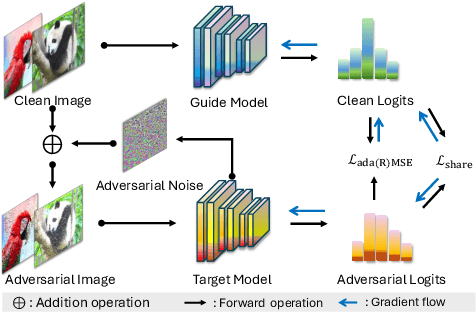
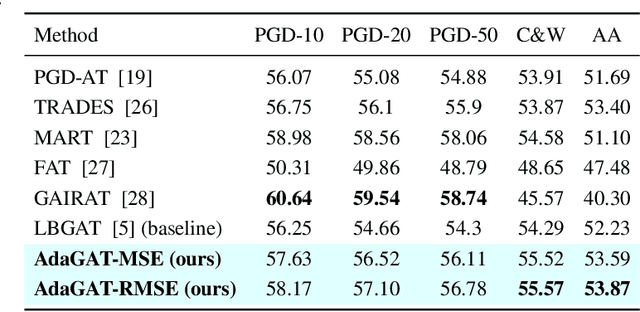
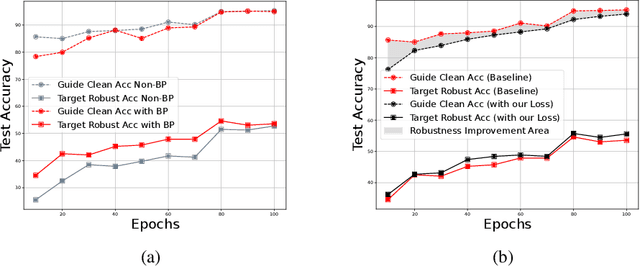
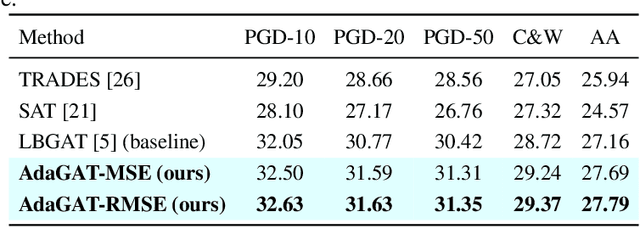
Abstract:Adversarial distillation (AD) is a knowledge distillation technique that facilitates the transfer of robustness from teacher deep neural network (DNN) models to lightweight target (student) DNN models, enabling the target models to perform better than only training the student model independently. Some previous works focus on using a small, learnable teacher (guide) model to improve the robustness of a student model. Since a learnable guide model starts learning from scratch, maintaining its optimal state for effective knowledge transfer during co-training is challenging. Therefore, we propose a novel Adaptive Guidance Adversarial Training (AdaGAT) method. Our method, AdaGAT, dynamically adjusts the training state of the guide model to install robustness to the target model. Specifically, we develop two separate loss functions as part of the AdaGAT method, allowing the guide model to participate more actively in backpropagation to achieve its optimal state. We evaluated our approach via extensive experiments on three datasets: CIFAR-10, CIFAR-100, and TinyImageNet, using the WideResNet-34-10 model as the target model. Our observations reveal that appropriately adjusting the guide model within a certain accuracy range enhances the target model's robustness across various adversarial attacks compared to a variety of baseline models.
Deep Learning-Assisted Detection of Sarcopenia in Cross-Sectional Computed Tomography Imaging
Aug 24, 2025Abstract:Sarcopenia is a progressive loss of muscle mass and function linked to poor surgical outcomes such as prolonged hospital stays, impaired mobility, and increased mortality. Although it can be assessed through cross-sectional imaging by measuring skeletal muscle area (SMA), the process is time-consuming and adds to clinical workloads, limiting timely detection and management; however, this process could become more efficient and scalable with the assistance of artificial intelligence applications. This paper presents high-quality three-dimensional cross-sectional computed tomography (CT) images of patients with sarcopenia collected at the Freeman Hospital, Newcastle upon Tyne Hospitals NHS Foundation Trust. Expert clinicians manually annotated the SMA at the third lumbar vertebra, generating precise segmentation masks. We develop deep-learning models to measure SMA in CT images and automate this task. Our methodology employed transfer learning and self-supervised learning approaches using labelled and unlabeled CT scan datasets. While we developed qualitative assessment models for detecting sarcopenia, we observed that the quantitative assessment of SMA is more precise and informative. This approach also mitigates the issue of class imbalance and limited data availability. Our model predicted the SMA, on average, with an error of +-3 percentage points against the manually measured SMA. The average dice similarity coefficient of the predicted masks was 93%. Our results, therefore, show a pathway to full automation of sarcopenia assessment and detection.
D2R: dual regularization loss with collaborative adversarial generation for model robustness
Jun 08, 2025Abstract:The robustness of Deep Neural Network models is crucial for defending models against adversarial attacks. Recent defense methods have employed collaborative learning frameworks to enhance model robustness. Two key limitations of existing methods are (i) insufficient guidance of the target model via loss functions and (ii) non-collaborative adversarial generation. We, therefore, propose a dual regularization loss (D2R Loss) method and a collaborative adversarial generation (CAG) strategy for adversarial training. D2R loss includes two optimization steps. The adversarial distribution and clean distribution optimizations enhance the target model's robustness by leveraging the strengths of different loss functions obtained via a suitable function space exploration to focus more precisely on the target model's distribution. CAG generates adversarial samples using a gradient-based collaboration between guidance and target models. We conducted extensive experiments on three benchmark databases, including CIFAR-10, CIFAR-100, Tiny ImageNet, and two popular target models, WideResNet34-10 and PreActResNet18. Our results show that D2R loss with CAG produces highly robust models.
Unified Few-shot Crack Segmentation and its Precise 3D Automatic Measurement in Concrete Structures
Jan 15, 2025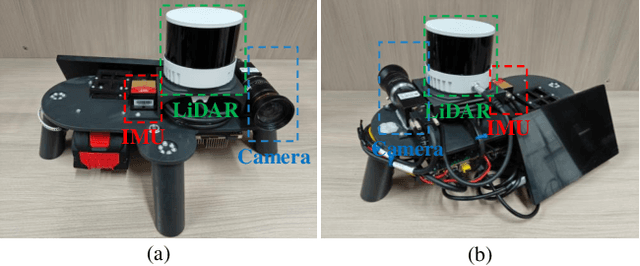
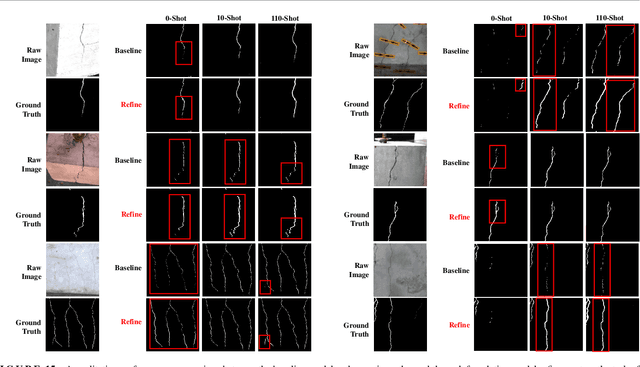
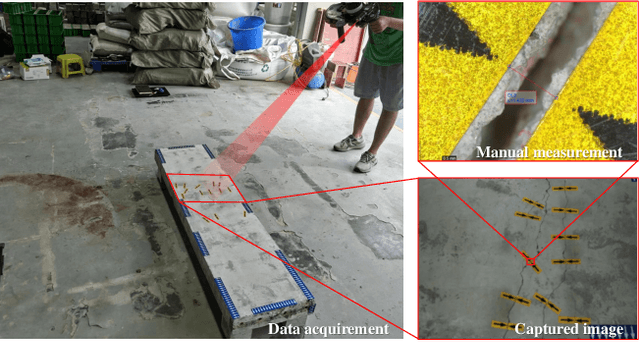
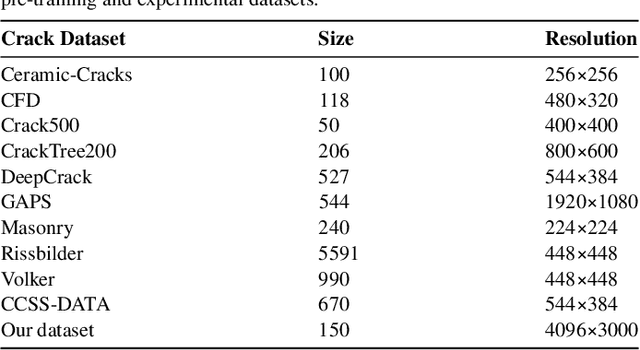
Abstract:Visual-Spatial Systems has become increasingly essential in concrete crack inspection. However, existing methods often lacks adaptability to diverse scenarios, exhibits limited robustness in image-based approaches, and struggles with curved or complex geometries. To address these limitations, an innovative framework for two-dimensional (2D) crack detection, three-dimensional (3D) reconstruction, and 3D automatic crack measurement was proposed by integrating computer vision technologies and multi-modal Simultaneous localization and mapping (SLAM) in this study. Firstly, building on a base DeepLabv3+ segmentation model, and incorporating specific refinements utilizing foundation model Segment Anything Model (SAM), we developed a crack segmentation method with strong generalization across unfamiliar scenarios, enabling the generation of precise 2D crack masks. To enhance the accuracy and robustness of 3D reconstruction, Light Detection and Ranging (LiDAR) point clouds were utilized together with image data and segmentation masks. By leveraging both image- and LiDAR-SLAM, we developed a multi-frame and multi-modal fusion framework that produces dense, colorized point clouds, effectively capturing crack semantics at a 3D real-world scale. Furthermore, the crack geometric attributions were measured automatically and directly within 3D dense point cloud space, surpassing the limitations of conventional 2D image-based measurements. This advancement makes the method suitable for structural components with curved and complex 3D geometries. Experimental results across various concrete structures highlight the significant improvements and unique advantages of the proposed method, demonstrating its effectiveness, accuracy, and robustness in real-world applications.
Exemplar-condensed Federated Class-incremental Learning
Dec 25, 2024



Abstract:We propose Exemplar-Condensed federated class-incremental learning (ECoral) to distil the training characteristics of real images from streaming data into informative rehearsal exemplars. The proposed method eliminates the limitations of exemplar selection in replay-based approaches for mitigating catastrophic forgetting in federated continual learning (FCL). The limitations particularly related to the heterogeneity of information density of each summarized data. Our approach maintains the consistency of training gradients and the relationship to past tasks for the summarized exemplars to represent the streaming data compared to the original images effectively. Additionally, our approach reduces the information-level heterogeneity of the summarized data by inter-client sharing of the disentanglement generative model. Extensive experiments show that our ECoral outperforms several state-of-the-art methods and can be seamlessly integrated with many existing approaches to enhance performance.
Dynamic Label Adversarial Training for Deep Learning Robustness Against Adversarial Attacks
Aug 23, 2024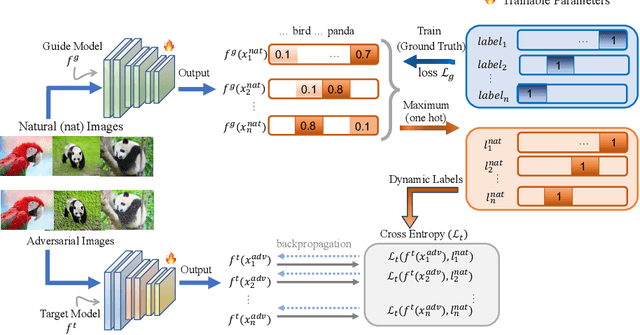
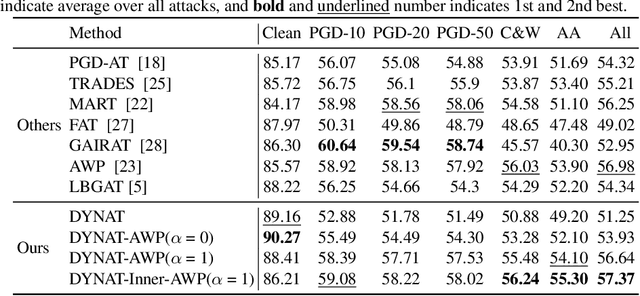
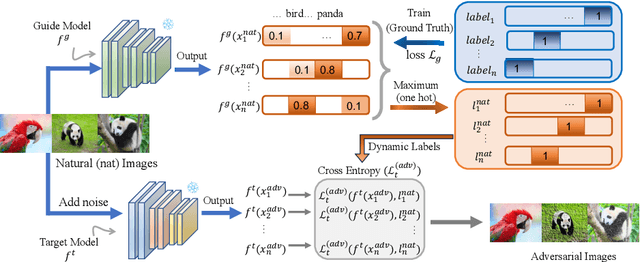

Abstract:Adversarial training is one of the most effective methods for enhancing model robustness. Recent approaches incorporate adversarial distillation in adversarial training architectures. However, we notice two scenarios of defense methods that limit their performance: (1) Previous methods primarily use static ground truth for adversarial training, but this often causes robust overfitting; (2) The loss functions are either Mean Squared Error or KL-divergence leading to a sub-optimal performance on clean accuracy. To solve those problems, we propose a dynamic label adversarial training (DYNAT) algorithm that enables the target model to gradually and dynamically gain robustness from the guide model's decisions. Additionally, we found that a budgeted dimension of inner optimization for the target model may contribute to the trade-off between clean accuracy and robust accuracy. Therefore, we propose a novel inner optimization method to be incorporated into the adversarial training. This will enable the target model to adaptively search for adversarial examples based on dynamic labels from the guiding model, contributing to the robustness of the target model. Extensive experiments validate the superior performance of our approach.
On Learnable Parameters of Optimal and Suboptimal Deep Learning Models
Aug 21, 2024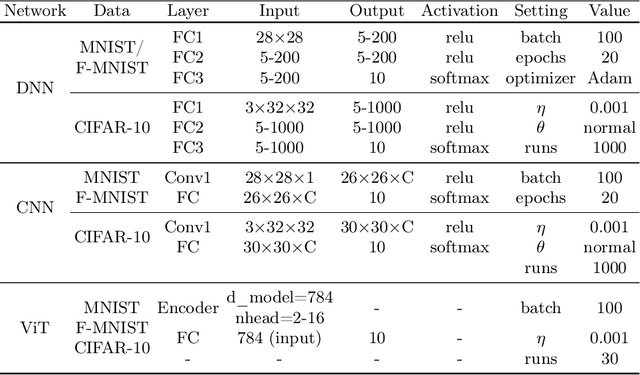
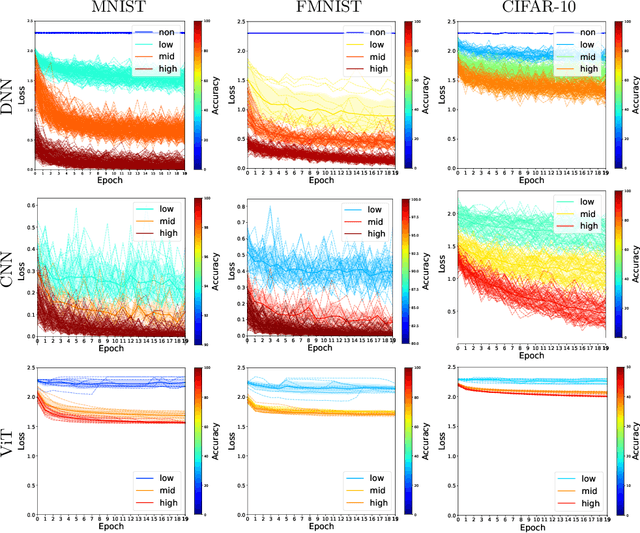
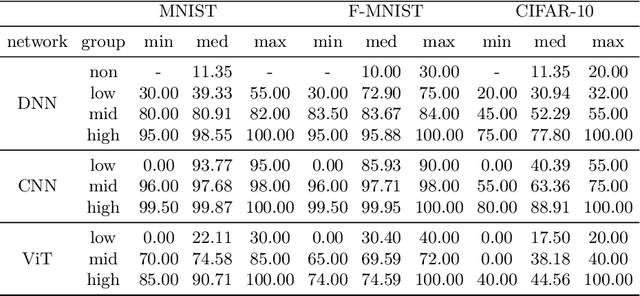
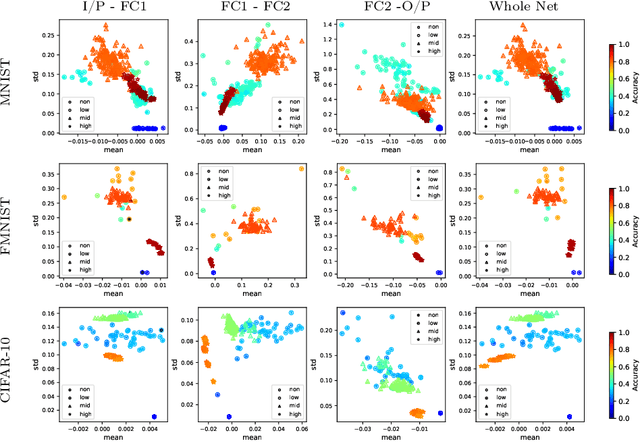
Abstract:We scrutinize the structural and operational aspects of deep learning models, particularly focusing on the nuances of learnable parameters (weight) statistics, distribution, node interaction, and visualization. By establishing correlations between variance in weight patterns and overall network performance, we investigate the varying (optimal and suboptimal) performances of various deep-learning models. Our empirical analysis extends across widely recognized datasets such as MNIST, Fashion-MNIST, and CIFAR-10, and various deep learning models such as deep neural networks (DNNs), convolutional neural networks (CNNs), and vision transformer (ViT), enabling us to pinpoint characteristics of learnable parameters that correlate with successful networks. Through extensive experiments on the diverse architectures of deep learning models, we shed light on the critical factors that influence the functionality and efficiency of DNNs. Our findings reveal that successful networks, irrespective of datasets or models, are invariably similar to other successful networks in their converged weights statistics and distribution, while poor-performing networks vary in their weights. In addition, our research shows that the learnable parameters of widely varied deep learning models such as DNN, CNN, and ViT exhibit similar learning characteristics.
Wearable-based behaviour interpolation for semi-supervised human activity recognition
May 24, 2024



Abstract:While traditional feature engineering for Human Activity Recognition (HAR) involves a trial-anderror process, deep learning has emerged as a preferred method for high-level representations of sensor-based human activities. However, most deep learning-based HAR requires a large amount of labelled data and extracting HAR features from unlabelled data for effective deep learning training remains challenging. We, therefore, introduce a deep semi-supervised HAR approach, MixHAR, which concurrently uses labelled and unlabelled activities. Our MixHAR employs a linear interpolation mechanism to blend labelled and unlabelled activities while addressing both inter- and intra-activity variability. A unique challenge identified is the activityintrusion problem during mixing, for which we propose a mixing calibration mechanism to mitigate it in the feature embedding space. Additionally, we rigorously explored and evaluated the five conventional/popular deep semi-supervised technologies on HAR, acting as the benchmark of deep semi-supervised HAR. Our results demonstrate that MixHAR significantly improves performance, underscoring the potential of deep semi-supervised techniques in HAR.
 Add to Chrome
Add to Chrome Add to Firefox
Add to Firefox Add to Edge
Add to Edge